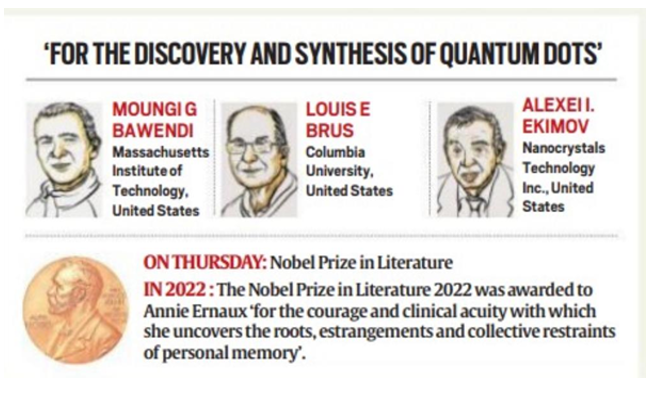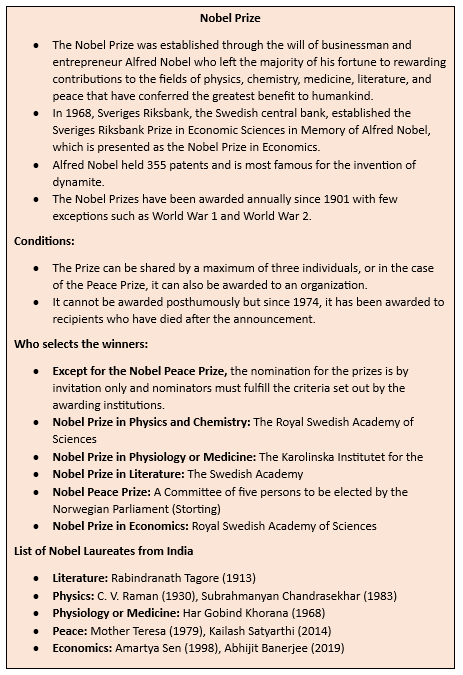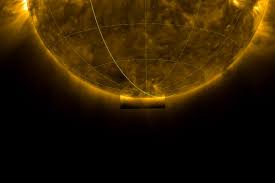- Courses
- GS Full Course 1 Year
- GS Full Course 2 Year
- GS Full Course 3 Year
- GS Full Course Till Selection
- Answer Alpha: Mains 2025 Mentorship
- MEP (Mains Enrichment Programme) Data, Facts
- Essay Target – 150+ Marks
- Online Program
- GS Recorded Course
- Polity
- Geography
- Economy
- Ancient, Medieval and Art & Culture AMAC
- Modern India, Post Independence & World History
- Environment
- Governance
- Science & Technology
- International Relations and Internal Security
- Disaster Management
- Ethics
- Current Affairs
- Indian Society and Social Issue
- NCERT- Science and Technology
- NCERT - Geography
- NCERT - Ancient History
- NCERT- World History
- CSAT
- 5 LAYERED ARJUNA Mentorship
- Public Administration Optional
- ABOUT US
- OUR TOPPERS
- TEST SERIES
- FREE STUDY MATERIAL
- VIDEOS
- CONTACT US
NOBEL PRIZE IN CHEMISTRY 2023
NOBEL PRIZE IN CHEMISTRY 2023
05-10-2023

Context
Recently, the Nobel Prize in Chemistry for 2023 was awarded to Moungi G. Bawendi, Louis E. Brus and Alexei I. Ekimov for their remarkable contributions to the field of quantum dots.
Contributions
- Louis Brus and Alexei Ekimov: Early in the 1980s, they each independently developed quantum dots.
- Ekimov discovered a quantum effect when he noted that the smaller particles were more blue after melting coloured glass and X-raying the results.
- The quantum effect in a liquid solution was first observed by Brus.
- Moungi Bawendi: He revolutionised the process of making quantum dots, which led to the creation of quantum dots of superior quality.
- Through a technique for carefully regulating colloid temperature, he was able to produce nanocrystals to the precise size he desired, enabling mass production.
What are quantum dots?
- Quantum dots are nanoparticles that are so small that their characteristics are determined by quantum effects.
- It is a brand-new category of materials that are neither bulky nor molecular.
- It is a semiconductor crystal of nanometer size that frequently only has a few thousand atoms.
- Size: A quantum dot's size ratio to a football is the same as a football's size ratio to the Earth.
- Despite having the same atomic makeup and structure as bulk materials, they can have their properties modified by changing just one factor, namely the particle size.
Significance
- The three award winners' work demonstrated various avenues for developing quantum dots. It also demonstrated how altering their size and make-up could change their optical characteristics. When activated by light, for instance, scientists can make them emit particular colours of light.
- Nanoscience: A critical milestone in the advancement of nanoscience is the discovery and manufacture of high-quality quantum dots using precise but relatively easy chemical techniques. Nanoscale particles acquire new, size-dependent features that can be controlled and utilised for novel uses. This is the fundamental tenet of nanoscience.
- Scope: The creation of high-quality quantum dots creates new opportunities for advancement in a variety of fields, including electronics, industrial catalysis, medicine, and others.
Applications of Quantum Dots
- Display Technology: By generating bright, clear light, quantum dots can improve the quality of displays like LED lights and television screens.
- Medical Imaging: They can shine a light on cancer tissue during surgery to help the surgeon remove it precisely.
- Slimmer Solar Cells: Quantum dots may produce solar cells that are more efficient and compact, enhancing renewable energy sources.
- Flexible Electronics: Flexible electronics could benefit from quantum dots, opening up new possibilities for creative and flexible technology.
- Encrypted Quantum Communication: The development of secure quantum communication techniques and the defence of confidential data may be aided by quantum dots.
Potential areas
- Lasers: Quantum dot-based lasers are more effective and flexible than conventional lasers. As a result, they may be applied more successfully in fields including materials processing, optical communications, and medical imaging.
- Drug delivery: They can be used to deliver medications to particular cells or tissues, which may increase therapeutic effectiveness and lessen negative effects.
- Biosensors: Due to their greater sensitivity and accuracy, quantum dot biosensors can be useful in the medical diagnostic industry. They can be used to more accurately detect particular diseases or biomolecules, such tumours.
concerns about quantum dots
- Toxic: Despite being poisonous, cadmium is used to create the majority of quantum dots due to its effectiveness in colour conversion.
- But researchers are working to create non-toxic quantum dots.
Other Recent Nobel Laureates in the Field of Chemistry
- 2022: Carolyn R. Bertozzi, Morten Meldal and K. Barry Sharpless “for the development of click chemistry and bioorthogonal chemistry”
- 2021: Benjamin List and David MacMillan “for the development of asymmetric organocatalysis”
- 2020: Emmanuelle Charpentier and Jennifer A. Doudna “for the development of a method for genome editing”
- 2019: John B. Goodenough, M. Stanley Whittingham and Akira Yoshino “for the development of lithium-ion batteries”
- 2018: Frances H. Arnold “for the directed evolution of enzymes”. George P. Smith and Sir Gregory P. Winter “for the phage display of peptides and antibodies”
Must Check: Best IAS Coaching In Delhi




